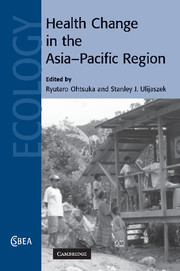Book contents
- Frontmatter
- Contents
- List of contributors
- Acknowledgements
- 1 Health change in the Asia-Pacific region: disparate end-points?
- 2 Interactions of nutrition, genetics and infectious disease in the Pacific: implications for prehistoric migrations
- 3 Biocultural adaptation and population connectedness in the Asia-Pacific region
- 4 Changing nutritional health in South East Asia
- 5 Obesity and nutritional health in Hong Kong Chinese people
- 6 Modernization, nutritional adaptability and health in Papua New Guinea Highlanders and Solomon Islanders
- 7 Tongan obesity: causes and consequences
- 8 Nutrition and health in modernizing Samoans: temporal trends and adaptive perspectives
- 9 Health patterns of Pacific Islanders and Asians in the United States
- 10 Impacts of modernization and transnationalism on nutritional health of Cook Islanders
- 11 Mortality decline in the Pacific: economic development and other explanations
- 12 Health changes in Papua New Guinea: from adaptation to double jeopardy?
- Index
- References
1 - Health change in the Asia-Pacific region: disparate end-points?
Published online by Cambridge University Press: 15 September 2009
- Frontmatter
- Contents
- List of contributors
- Acknowledgements
- 1 Health change in the Asia-Pacific region: disparate end-points?
- 2 Interactions of nutrition, genetics and infectious disease in the Pacific: implications for prehistoric migrations
- 3 Biocultural adaptation and population connectedness in the Asia-Pacific region
- 4 Changing nutritional health in South East Asia
- 5 Obesity and nutritional health in Hong Kong Chinese people
- 6 Modernization, nutritional adaptability and health in Papua New Guinea Highlanders and Solomon Islanders
- 7 Tongan obesity: causes and consequences
- 8 Nutrition and health in modernizing Samoans: temporal trends and adaptive perspectives
- 9 Health patterns of Pacific Islanders and Asians in the United States
- 10 Impacts of modernization and transnationalism on nutritional health of Cook Islanders
- 11 Mortality decline in the Pacific: economic development and other explanations
- 12 Health changes in Papua New Guinea: from adaptation to double jeopardy?
- Index
- References
Summary
Introduction
The Asia-Pacific region encompasses South East Asia, East Asia, Pacific Islands and the islands of Melanesia. In the present day, strong economic forces link it to the Pacific Rim nations of the United States, Australia and New Zealand. While epidemiologists have studied some of the relationships across geographical and population units within this region, there is thus far no formal consideration of health impacts of linkages within and across these units in historical and evolutionary contexts. While migrations across the region are known and common, these have both evolutionary and colonial histories. The nature and extent to which knowledge of population movements, past and recent, can impact on present-day human biology in this region has not been synthesized, despite having been considered separately by various authors and research groups. This volume considers recent evidence concerning prehistoric migration, and colonial, regional and global processes in the production of health in the Asia-Pacific region. Using their own research findings and/or by synthesizing those of others, the contributors to this volume describe health change in various populations in relation to their biological, cultural and/or socioeconomic attributes at various scales of time.
This region, consisting of the southeastern frontier of the Eurasian continent and the vast South Pacific, was the geographical locale of the first crossing of wide seas and oceans by human groups. A consequence of this was the adaptation of such migrant groups to a variety of novel environments.
- Type
- Chapter
- Information
- Health Change in the Asia-Pacific Region , pp. 1 - 20Publisher: Cambridge University PressPrint publication year: 2007



